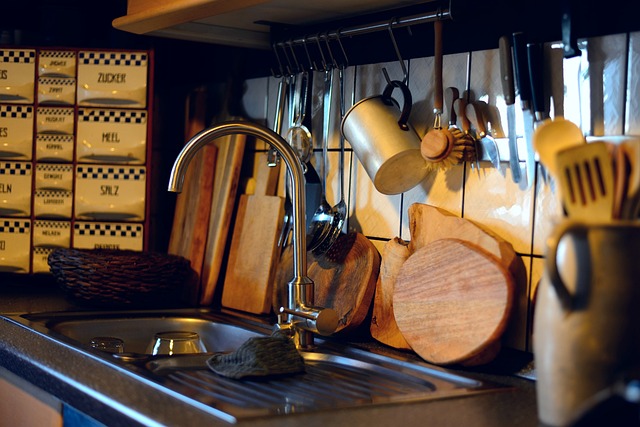Looking to transform your kitchen into an eco-friendly oasis while saving money? This comprehensive guide explores energy-efficient kitchen remodel ideas that combine style with sustainability. We delve into the significant environmental and financial benefits of energy-efficient design choices, from smart appliance selections to low-flow fixtures. Discover how to create a functional, beautiful kitchen that reduces your carbon footprint without compromising on quality or style. Get ready to embark on a journey towards a greener future, one culinary space at a time.
# Kitchen Remodel for Energy Efficiency: A Comprehensive Guide to Sustainable Upgrades
A kitchen remodel presents an excellent opportunity to embrace energy efficiency and sustainable living. By integrating eco-friendly practices during renovation, homeowners can significantly reduce their carbon footprint while enjoying long-term savings on utility bills. This comprehensive guide explores various aspects of green kitchen remodeling, from design choices to specific upgrades, empowering you to make informed decisions for a more sustainable home.
Energy-efficient kitchen design focuses on minimizing waste and optimizing natural resources. Consider low-energy lighting options like LED bulbs, which consume less power and have longer lifespans compared to traditional incandescent lights. Appliances play a significant role; modern energy-saving models boast advanced technologies that reduce electricity usage without compromising performance. Additionally, smart home devices can automate temperature controls and lighting, further enhancing energy conservation in the kitchen.
The Impact of Energy-Efficient Kitchen Design
An energy-efficient kitchen remodel isn’t just about aesthetics; it’s a powerful way to reduce your environmental impact and lower utility bills. By incorporating eco-friendly design principles, you can create a space that minimizes energy consumption without compromising functionality or style. Simple changes like swapping traditional lighting for low-energy LED fixtures can significantly cut down on electricity usage, while energy-saving kitchen appliances offer substantial long-term savings.
Sustainable kitchen renovations go beyond individual appliance choices. Strategic planning and design play a crucial role in creating an efficient space. This might involve installing better insulation to reduce heat loss, using natural lighting where possible, and selecting materials with lower environmental impacts. These measures not only contribute to a greener lifestyle but also make economic sense over time, ensuring your kitchen is both eco-friendly and cost-effective.
– Understanding the environmental and financial benefits.
A kitchen remodel offers an excellent opportunity to embrace eco-friendly practices and significantly reduce your home’s environmental impact. By prioritizing energy efficiency, you can save money on utility bills while contributing to a greener planet. Energy-efficient kitchen design involves strategic choices that minimize power consumption without compromising functionality or aesthetics.
Upgrading to energy-saving appliances, such as low-energy lighting, efficient refrigerators, and induction cooktops, is a powerful step towards sustainability. These changes not only lower your carbon footprint but also provide long-term financial benefits. Eco-friendly kitchen renovations often result in significant returns on investment due to the reduced need for electricity and water, making it a smart decision for both your wallet and the environment.
– How efficient design choices can reduce energy consumption without compromising functionality.
A well-designed kitchen remodel can significantly reduce energy consumption while maintaining a functional and stylish space. Efficient design choices, such as proper insulation, energy-saving windows, and strategic placement of appliances, play a crucial role in minimizing energy waste. For instance, using low-energy lighting fixtures like LED bulbs not only reduces electricity bills but also contributes to a greener environment.
Eco-friendly kitchen upgrades include integrating smart thermostats that optimize heating and cooling systems, installing energy-efficient sinks and faucets with water-saving features, and utilizing high-performance appliances with advanced energy-saving technologies. These measures not only cut down on utility expenses but also promote sustainable living by reducing the carbon footprint associated with household operations. Green kitchen remodeling focuses on these strategic interventions to create a harmonious blend of environmental consciousness and practical design.
Eco-Friendly Kitchen Upgrades: Materials and Fixtures
When considering a kitchen remodel with an eye towards both cost savings and environmental responsibility, selecting eco-friendly materials is paramount. Opting for options like recycled or sustainably sourced wood, bamboo, or linoleum for countertops and flooring not only reduces your carbon footprint but can also offer long-term financial benefits due to their durability and low maintenance requirements. Additionally, incorporating natural insulation materials such as cellulose or wool can significantly enhance energy efficiency by keeping heat in during winter and out during summer, thereby reducing heating and cooling costs.
Beyond materials, choosing energy-saving fixtures is another crucial step in an eco-friendly kitchen renovation. Low-flow faucets and showerheads drastically cut water consumption without compromising performance. LED lighting, both functional and aesthetic, uses up to 85% less energy than traditional incandescent bulbs and has a significantly longer lifespan. Moreover, smart appliances that are ENERGY STAR certified promise substantial energy savings—up to 20% more efficient than standard models—without sacrificing performance or convenience.
A sustainable kitchen remodel isn’t just an investment in your home; it’s a commitment to a greener future. By adopting energy-efficient kitchen design principles and eco-friendly upgrades, you can significantly reduce your carbon footprint while saving on energy bills. Incorporating energy-saving kitchen appliances, low-energy lighting for kitchens, and choosing sustainable materials are key steps towards a green kitchen renovation. These changes not only benefit the environment but also enhance the functionality and aesthetics of your space, proving that energy efficiency and style can go hand in hand.
